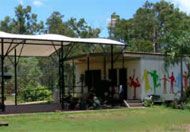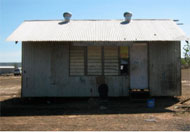Education
Can remote Aboriginal schools compete?
Schools in remote Aboriginal communities receive less resources than similar schools in towns with mainly non-Aboriginal students. Read about their surprising advantage and the myths associated with them.

Wishing you knew more about Aboriginal culture? Search no more.
Get key foundational knowledge about Aboriginal culture in a fun and engaging way.
This is no ordinary resource: It includes a fictional story, quizzes, crosswords and even a treasure hunt.
Stop feeling bad about not knowing. Make it fun to know better.
Selected statistics
Remove school vs. regional school
Here is a comparison of resources provided to two similar school communities based on data from the Institute for Cultural Survival. [2] One school is located in Arnhemland, where mostly Aboriginal students speak Aboriginal languages, the other in a regional location where the mostly white students speak English.
Regional: Dundee Beach school
The Dundee Beach community was originally established as a weekend fishing retreat. It is a small, predominantly non-Aboriginal township located about 62 kms as the crow flies from Darwin. Dundee Beach School is a regular school and had 6 students enrolled in 2009.
Remote: Mirrngatja Remote School
Mirrngatja is a small, permanently occupied township located in east Arnhemland (see the green arrow in the map below). Mirrngatja is about 475 kms as the crow flies from Darwin (Google maps wouldn't find it unless you enter coordinates). Mirrngatja school is a Remote School and had 13 students enrolled in 2009.
The struggle of remote schools
Currently in the Northern Territory there are about 15 out of 151 schools with attendances below 20, all of which receive full government funding. Yet, 45 remote Aboriginal school populations with at least comparable and in many cases greater numbers are unable to access the same level of schooling facilities and service as their white counterparts because they are classified as Homeland Learning Centres.
Note how the government treats these centres differently in the table below.
| Regional school (Dundee Beach) | Remote school (Mirrngatja) | |
|---|---|---|
 |  | |
| Year opened | 1998 | 1982 |
| DET classification | School | Homeland Learning Centre |
| Student numbers in 2009 | 6 | 13 |
| Students' first language | English | Djambarrpuyngu, Ganalbingu |
| Resident teacher | ✔ (full-time) | ✘ (visiting teacher 1 day per week) |
| Resident assistant teacher | ✔ | ✔ |
| School infrastructure | ||
| Classroom | ✔ (paid for by DET) | ✔ (paid for and built by parents) [3] |
| Classroom aircon | ✔ | ✘ |
| Library room | ✔ | ✘ |
| Ablution block | ✔ | ✘ |
| Shaded play area | ✔ | ✘ |
| Office | ✔ | ✘ |
| Teacher accommodation | ✔ (2-bedroom) | ✘ |
| School vehicle | ✔ | ✘ |
| Carport | ✔ | ✘ |
| Running water | ✔ | ✘ |
| Electricity | ✔ (generators purchased by the NT government) | ✔ (through solar installation for community) |
| Classroom resources | ||
| Reading schemes | ✔ | ✘ |
| Class sets of readers | ✔ | ✘ |
| Class sets of text books | ✔ | ✘ |
| Classroom services | ||
| Languages taught | English, Indonesian, Auslan | English |
| Interactive distance learning | ✔ | ✔ (by phone) |
| Internet | ✔ | ✘ |
| Classroom equipment | ||
| Computers | ✔ (8 computers) | ✘ |
| Smart board | ✔ | ✘ |
| Printer | ✔ | ✘ |
| Scanner | ✔ | ✘ |
| Office equipment | ||
| Computer | ✔ | ✘ |
| Photocopier | ✔ | ✘ |
| Fax machine | ✔ | ✘ |
| Printer | ✔ | ✘ |
| Phone | ✔ | ✘ |
| Finances | ||
| Infrastructure investment by government over life of school | $1,500,000 (estimate) | $200 |
| Repairs and maintenance carried out | ✔ | Rarely |
| Received funding through the government's $11.7 billion funding "available to every Australian school" | ✔ | ✘ |
Indigenous Australians living on outstations (homelands) receive services comparable to those received by other Australians living in a community of similar size, location and need.
— Jenny Macklin, former Indigenous Affairs Minister [2]
Myths about remote education
Check your (often unconscious) assumptions and opinions about teaching in a remote community: [1]
Myth: Remoteness is a disadvantage
We use 'remoteness' as a geographical idea that assumes there is such a thing as a ‘centre’. Both the Australian Bureau of Statistics and the My School website have indexes that imply or openly include remoteness as components of disadvantage. School funding depends on it.
But is remoteness itself a disadvantage? And is remoteness a reasonable way to measure the diverse needs of those who live outside urban places?
Many high achievers came from remote places. In fact, for many successful Aboriginal painters it was a necessity so they could connect to country and deliver stunning artworks.
Myth: There are no jobs in remote communities
Data shows that non-Aboriginal employment in remote communities has grown considerably and that unemployment rates in communities is not as high as you might think, though labour force participation is relatively low.
But who defines what 'work' is? The Aboriginal perspective might be very different to yours:
"You [non-Aboriginal person] work for yourself, take responsibility for yourself, or maybe just your little family. I [am] always working for family, that’s my main job, being responsible to family. Mother’s side, father’s side, husband ones, always working to show them I love and respect them. Then I know they will be there for my son and be working for him." [1]
Myth: Education (or training) is the ‘key’
If you believe that you need higher education and training for remote communities you'll be surprised to learn that more than 30% of all jobs require no more than Year 10, and no post-school, qualifications.
While the post-school qualifications among Aboriginal people increased 6-fold in the ten years to 2011, their employment only increased by 10%.
Training doesn’t lead to work. Mostly, work leads to training.
Myth: We’ve just got to get kids to school
"How can the kids learn if they don’t go to school?" is an often-asked question. The Remote School Attendance Strategy, the School Enrolment and Attendance Measure and truancy officers all try to address Aboriginal school attendance rates which fall the more remote a school is. [4]
But do these attendance strategies work? Does increased attendance lead to economic prosperity?
My School data shows the more remote schools employ non-teaching staff, the better their average attendance rate will be. [1]
Myth: Quality teachers make the most difference
In a 2003 study John Hattie from the University of Auckland found that "students who are taught by expert teachers exhibit an understanding of the concepts targeted in instruction that is more integrated, more coherent, and at a higher level of abstraction than the understanding achieved by other students". [5]
But what defines a quality teacher? Their qualifications or their experience? Or something else? What works is working together to build local capacity.
For more myth busting, check out a collection of myths you might believe about Aboriginal Australia.
Remote schools have surprising benefits
You might assume that attending regional schools is far better than going to a remote school because they are closer to places where a lot of people live. But that's exactly their disadvantage.
Senior ceremonial leader and leader of the Yolngu Madarrpa clan, Djambawa Marawili, of North East Arnhem Land, explains why remoteness is an advantage for schools:
"Why do you want to build a boarding school which is right in the middle of the town where a lot of influences [such as alcohol and drugs] will be there? How will those children be managing? Do you want to put a big fence around their area or what you want to do? You should be really looking at our future. I think we should be having boarding schools somewhere else where it [is] really quiet and they can concentrate their minds on reading and writing.
"Choose one of the homelands and put the boarding school there for us! That way we can manage and we can look after those schools. School is more important... For the future of our young generations they should be at a really quiet, humble school so that they can concentrate their minds and they can think." [6]
I think we should be having boarding schools somewhere else where it [is] really quiet.
— Djambawa Marawili, leader of the Yolngu Madarrpa clan [6]